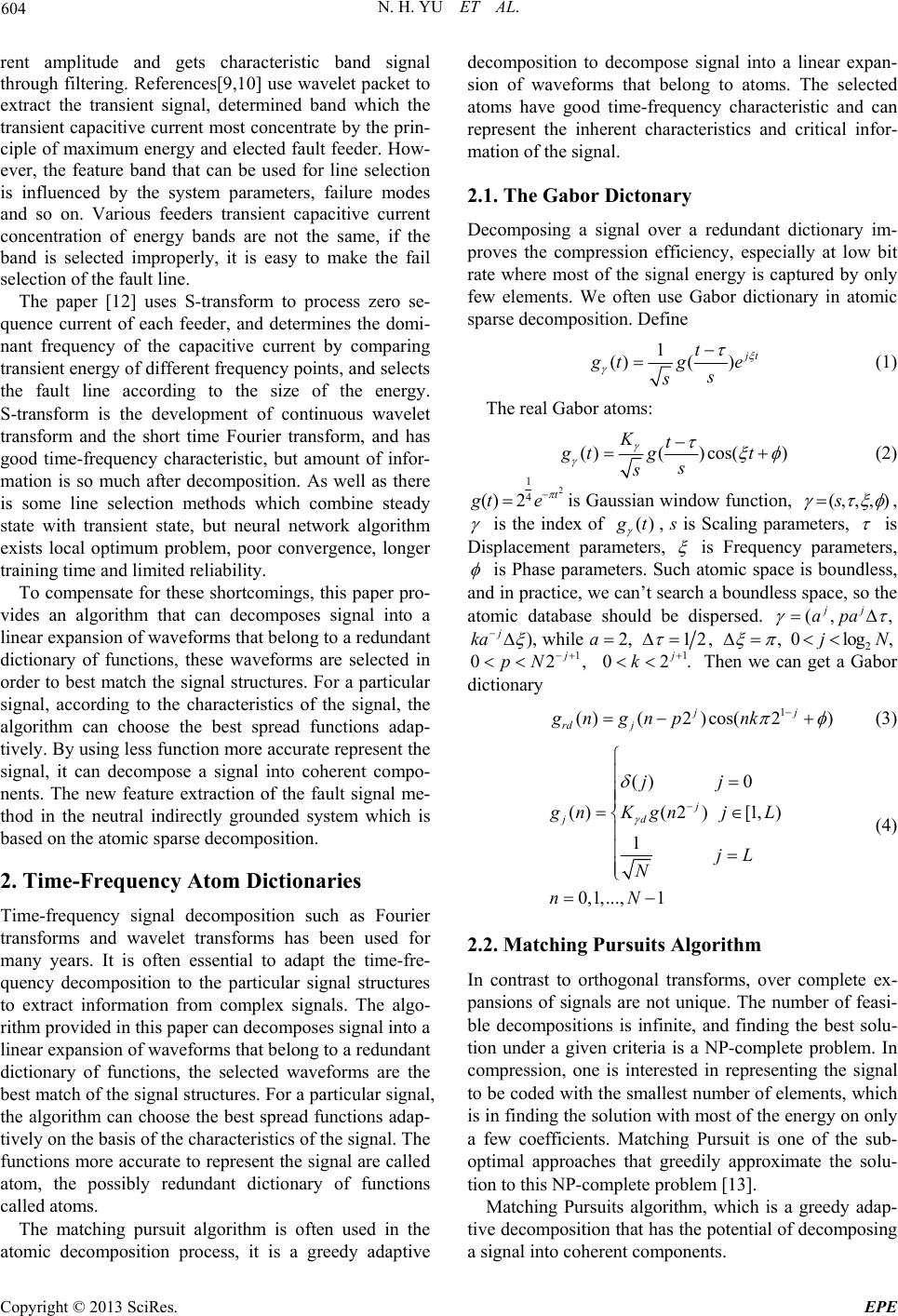
N. H. YU ET AL.
604
rent amplitude and gets characteristic band signal
through filtering. References[9,10] use wavelet packet to
extract the transient signal, determined band which the
transient capacitive cu rrent most concentrate by the prin-
ciple of maximum energy and elected fault feeder. How-
ever, the feature band that can be used for line selection
is influenced by the system parameters, failure modes
and so on. Various feeders transient capacitive current
concentration of energy bands are not the same, if the
band is selected improperly, it is easy to make the fail
selection of the fault line.
The paper [12] uses S-transform to process zero se-
quence current of each feeder, and determines the domi-
nant frequency of the capacitive current by comparing
transient energy of different frequency points, and selects
the fault line according to the size of the energy.
S-transform is the development of continuous wavelet
transform and the short time Fourier transform, and has
good time-frequency characteristic, but amount of infor-
mation is so much after decomposition. As well as there
is some line selection methods which combine steady
state with transient state, but neural network algorithm
exists local optimum problem, poor convergence, longer
training time and limited reliability.
To compensate for these shortcomings, this paper pro-
vides an algorithm that can decomposes signal into a
linear expansion of waveforms that belong to a redundant
dictionary of functions, these waveforms are selected in
order to best match the signal structures. For a particular
signal, according to the characteristics of the signal, the
algorithm can choose the best spread functions adap-
tively. By using less function more accurate represent the
signal, it can decompose a signal into coherent compo-
nents. The new feature extraction of the fault signal me-
thod in the neutral indirectly grounded system which is
based on the atomic sparse decomposition.
2. Time-Frequency Atom Dictionaries
Time-frequency signal decomposition such as Fourier
transforms and wavelet transforms has been used for
many years. It is often essential to adapt the time-fre-
quency decomposition to the particular signal structures
to extract information from complex signals. The algo-
rithm provided in this paper can decomposes signal into a
linear expansion of waveforms that belong to a redundant
dictionary of functions, the selected waveforms are the
best match of the signal structures. For a particular signal,
the algorithm can choose the best spread functions adap-
tively on the basis of the characteristics of the signal. The
functions more accurate to represent the signal are called
atom, the possibly redundant dictionary of functions
called atoms.
The matching pursuit algorithm is often used in the
atomic decomposition process, it is a greedy adaptive
decomposition to decompose signal into a linear expan-
sion of waveforms that belong to atoms. The selected
atoms have good time-frequency characteristic and can
represent the inherent characteristics and critical infor-
mation of the signal.
2.1. The Gabor Dictonary
Decomposing a signal over a redundant dictionary im-
proves the compression efficiency, especially at low bit
rate where most of the signal energy is captured by only
few elements. We often use Gabor dictionary in atomic
sparse decomposition. Define
1
()( )
t
t
tge
s
s
(1)
The real Gabor atoms:
()( )cos()
Kt
gt gt
s
s
(2)
2
1
4
() 2t
te
is Gaussian window function, (,, , )s
,
is the index of ()
t
, s is Scaling parameters,
is
Displacement parameters,
is Frequency parameters,
is Phase parameters. Such atomic space is boundless,
and in practice, we can’t search a boundless space, so the
atomic database should be dispersed. (,
jj
apa ,
),
j
ka
while 2,a
12,
,
2
0l ogjN ,
1j
02pN ,
1
2
j
0k.
Then we can get a Gabor
dictionary
1
()(2)cos( 2)
jj
rd j
gn gnpnk
(3)
() 0
()(2)[1, )
1
0,1,..., 1
j
jd
jj
nKgn jL
jL
N
nN
(4)
2.2. Matching Pursuits Algorithm
In contrast to orthogonal transforms, over complete ex-
pansions of signals are not unique. The number of feasi-
ble decompositions is infinite, and finding the best solu-
tion under a given criteria is a NP-complete problem. In
compression, one is interested in representing the signal
to be coded with the smallest number of elements, which
is in finding the solution with most of the energy on only
a few coefficients. Matching Pursuit is one of the sub-
optimal approaches that greedily approximate the solu-
tion to this NP-complete problem [13].
Matching Pursuits algorithm, which is a greedy adap-
tive decomposition that has the potential of decomposing
a signal into coherent components.
Copyright © 2013 SciRes. EPE